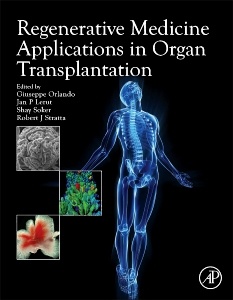Description
Regenerative Medicine Applications in Organ Transplantation
Coordinator: Orlando Giuseppe
Language: English
Subjects for Regenerative Medicine Applications in Organ Transplantation:
1050 p. · 21.4x27.6 cm · Hardback
Description
/li>Contents
/li>Readership
/li>Biography
/li>Comment
/li>
Regenerative Medicine Applications in Organ Transplantation illustrates exactly how these two fields are coming together and can benefit one another. It discusses technologies being developed, methods being implemented, and which of these are the most promising. The text encompasses tissue engineering, biomaterial sciences, stem cell biology, and developmental biology, all from a transplant perspective. Organ systems considered include liver, renal, intestinal, pancreatic, and more. Leaders from both fields have contributed chapters, clearly illustrating that regenerative medicine and solid organ transplantation speak the same language and that both aim for similar medical outcomes. The overall theme of the book is to provide insight into the synergy between organ transplantation and regenerative medicine.
Recent groundbreaking achievements in regenerative medicine have received unprecedented coverage by the media, fueling interest and enthusiasm in transplant clinicians and researchers. Regenerative medicine is changing the premise of solid organ transplantation, requiring transplantation investigators to become familiar with regenerative medicine investigations that can be extremely relevant to their work. Similarly, regenerative medicine investigators need to be aware of the needs of the transplant field to bring these two fields together for greater results.
Meet the Editors Preface 1. Introduction: Regenerative medicine and solid organ transplantation from a historical perspective 2. Solid organ transplantation: has the promise been kept and the needs met?
Principles of Regenerative Medicine and Cell, Tissue, and Organ Bioengineering 3. Strategies for the specification of tissue engineering biomaterials 4. Principles of Stem Cell Biology 5. Principles of cell sheet technology 6. Principles of bioprinting technology 7. Synthetic biomaterial for regenerative medicine applications 8. Natural biomaterials for regenerative medicine applications 9. Bioartificial biomaterials for regenerative medicine applications 10. Bioactivated materials for cell and tissue guidance 11. Biocompatibility and immune response to biomaterials 12. Harnessing regenerative and immunomodulatory properties of stem cells 13. Bioreactors for tissue engineering purposes
Kidney 14. Current status of renal transplantation 15. Living related renal transplantation: progress, pitfalls and promise 16. Machine perfusion of kidneys donated after cardiac death: the Carrel and Lindbergh legacy 17. Renal regeneration: the bioengineering approach 18. Renal regeneration: the stem cell biology approach 19. Renal regeneration: the developmental approach
Liver 20. Current status of liver transplantation 21. Living related liver transplantation: progress, pitfalls and promise 22. Donation after cardiac death liver transplantation 23. Artificial liver support 24. Liver regeneration: the bioengineering approach 25. Liver regeneration: the developmental biology approach 26. Liver regeneration: the stem cell approach 27. Liver bioengineering using human cells
Heart 28. Current status of heart transplantation 29. Artificial heart support 30. Heart regeneration: the bioengineering approach 31. Heart regeneration: the developmental and stem cell biology approach
Small Bowel 32. Current status of intestinal transplantation 33. Living related small bowel transplantation: progress, pitfalls and promise 34. Intestinal regeneration: the bioengineering approach 35. Intestinal regeneration: the developmental biology approach 36. Intestinal regeneration: stem cell approach 37. Building blocks for engineering the small intestine
Endocrine pancreas and islets of Langerhans 38. Current status of pancreas transplantation 39. Living related pancreas transplantation: progress, pitfalls and promise 40. Current status of islet transplantation 41. Pancreatic islets regeneration: the bioengineering approach 42. Pancreatic islet regeneration: the developmental and stem cell biology approach 43. Microencapsulation technology 44. Autologous islets transplantation
Lung 45. Current status of lung transplantation 46. Living related lung transplantation: progress, pitfalls and promise 47. Artificial Lung Support 48. Lung regeneration: the bioengineering approach 49. Lung regeneration: the developmental biology approach 50. Lung regeneration: stem cell approach
Composite tissues allotransplantation Immunosuppression-free transplantation in the regenerative medicine era Epilogue: Organ Bioengineering and Regeneration as the new Holy Grail of Organ Transplantation
Basic and clinical researchers in the fields of regenerative medicine, transplantation, tissue engineering, biomaterial sciences, stem cell biology, developmental biology, and related fields
- Bridges the gap between regenerative medicine and solid organ transplantation and highlights reasons for collaboration
- Explains the importance and future potential of regenerative medicine to the transplant community
- Illustrates to regenerative medicine investigators the needs of the transplant discipline to drive and guide investigations in the most promising directions




